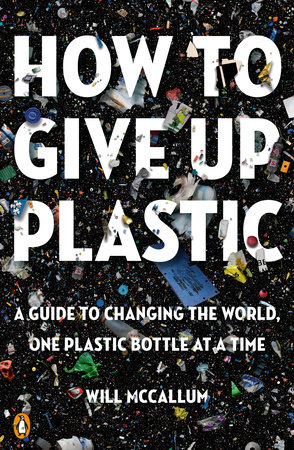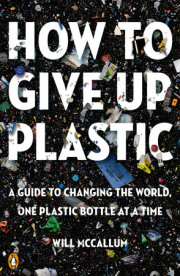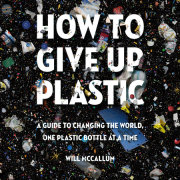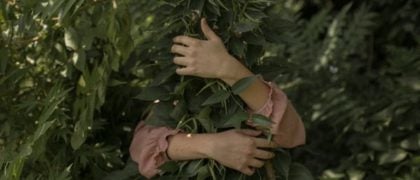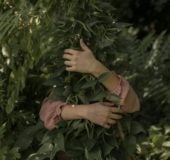"Can I grab you quickly? Take a look at this."
Grant Oakes, our biosecurity officer on board the Arctic Sunrise, Greenpeace's icebreaker vessel, grabs me from the canteen and takes me to our makeshift lab in the hold where he has set up a microscope. As he rotates the Petri dish a round beneath the lens of the microscope, I focus in on the offending object-hard, bright pink with serrated edges, it is obviously not from natural sources. It seems we have found our first fragment of plastic in the pristine Antarctic waters we are sailing in. A couple more colleagues join us and we take turns to examine it. We cannot confirm whether it is plastic until next month when we will take it back to our laboratory in Exeter University for analysis, but to the untrained eye it is hard to imagine it is anything else. (A few weeks later the results revealed that we had found two fragments of plastic in waters hundreds of miles from permanent human habitation.)
The reaction in the canteen is far from surprised; if anything, we expected to see these results sooner. Greenpeace ships have been testing for plastics in the ocean since the mid-1990s and in the past few years its presence in our trawls has increased more and more across every ocean the ships sail in. As is becoming common practice on each of Greenpeace's three ships, we are taking every opportunity, weather and ice permitting, to do what is known as a manta trawl-using a fine-mesh net, about a meter across at the mouth, to test for plastics in the water. From the frozen Arctic tundra to the deepest trenches in the ocean, scientists have found plastics almost everywhere they have searched, so why not down here in the Antarctic as well, at the bottom of the world, despite its lack of permanent inhabitants.
We have been sailing here for nearly two months now. We are working with scientists, journalists and celebrities to raise awareness about the need to protect this vast wilderness. It is a landscape like none other I have experienced-much of the time clouded in deep fog that occasionally lifts to reveal dramatic peaks and enormous glaciers cascading down into the water. The main topic of conversation on board is the unbelievable abundance of wildlife around us at all times. Fix your gaze on a stretch of water for long enough and you are almost guaranteed to spot the fin of a humpback whale dawdling past or a small group of penguins porpoising out of the water in between the contorted icebergs that surround us. It is sobering to think that even these icy waters, teeming with wildlife wholly unconcerned with us humans, are beginning to be polluted by plastics being produced halfway across the world.
It doesn't take a trip all the way down to the Antarctic to come to this grim conclusion. Everybody I speak to about the issue has had the experience of plastic encroaching on a beloved landscape. It is nearly impossible to visit our favorite beaches or walk along a river without spotting some floating plastic debris drifting menacingly out to sea. The problem of plastic pollution is one close to the heart of so many people because it is affecting all of us, every day. From the tabloids plastering it on the front pages to politicians having lengthy debates in the Houses of Parliament, from ordinary households attempting to go plastic free to celebrity endorsements of products that purport to be better for the environment, everyone is talking about the need to find a solution to the tide of plastic flowing into our oceans.
People across the world have woken up to the ridiculousness of the situation we are in: we managed to create a material and use it at unbelievable scale with no plan for how to deal with it afterward. Single-use plastic cutlery, plastic bags and plastic-lined coffee cups have become central to our lives-used once for a matter of minutes, they will not break down for hundreds of years. It is untenable to carry on like this: we are consigning future generations to a world in which plastic might outweigh fish in the ocean by 2050. This mind-boggling statistic, together with our shared anger at overpackaging and useless plastic products, is galvanizing a global movement prepared to go beyond just talking about the problem and to actually start doing something about it.
This book is for those who want to act now but don't know where to begin. In the face of a problem on this scale it can be hard to work out what your role is; whether you can actually make a difference. I don't claim to have all the answers, far from it, but having spent a few years campaigning to reduce plastics, talking to people about their experiences, negotiating with companies and politicians about what can be done, I've compiled this useful guide to help you play a part in ending ocean plastics. From the kitchen cupboard to the boardrooms of multinational companies, the movement to end plastic pollution needs everyone to come on board and do what they can-at home, where they work and in their community.
If you take one message from the book it is this: that the problem of plastic pollution is one that affects us all, and therefore one for which we all share responsibility as individuals but also, more importantly, collectively. As individuals we can change our behavior, limit our use and help reduce, even by a little bit, the amount of plastic out there. Working together we can achieve much, much more. Amplifying your actions by talking about them with your friends, colleagues and on social media, you can have so much more impact than only working behind closed doors; and joining forces with others in your community to send the message loud and clear to those with more power in politics and business is perhaps the best opportunity we have to get to a world without plastic pollution.
The problem of plastic pollution is one that affects us all, and therefore one for which we all share responsibility as individuals but also,
more importantly, collectively.
My Top Five Steps for Getting Rid of Plastic
Just in case you get no further than this introduction-you lose the book or don't have time-then in the spirit of being a useful guide for anyone, no matter who they are and what their circumstances are, here are my top five steps for getting rid of plastic, right at the very beginning.
1Go on a plastic-free shopping spree. Who would have thought in a book about reducing the amount of waste we produce the top advice for getting rid of plastic was to go and buy a few things? Essential items for a plastic-free life include: a nice water bottle, a reusable coffee cup, a tote bag (or even just a backpack) for your shopping, a lunch box and some kitchen storage containers.
2Go on a plastic-free purge. Start in your bathroom, work your way to the bedroom and then into the kitchen. Have a look at ingredients lists on the back of your cosmetic products to check there aren't any microbeads; empty your cupboards of single-use plastic straws and cutlery. Don't know what to do with it all? You could always send it back to whoever you bought it from with a message that, in your household, single-use plastic is no longer welcome.
3Do some plastic-free preaching. All of us are way more likely to take advice if it comes from our friends and family, rather than just reading about it in a book or watching it on the television. Pass on handy tips to your friends and neighbors (you could even give them a copy of this book). Spread the good news that a plastic-free life is easier than they think, and every little bit helps.
4Make some plastic-free plans. It's true that getting rid of plastic takes a bit of planning. Use a rainy day to sit down and work out which shops near you already use less plastic. Do you have a local grocery that lets you pack your fruit and vegetables however you want? If there are only fast-food outlets near your place of work, spend some time making food for a week of packed lunches. Start thinking about your plastic-free routine and write it down in your diary.
5Start your own plastic-free campaign. Go out in your neighborhood and see what businesses are using too much plastic, and which ones are the local champions. Talk to business owners about what they could be doing to use less plastic. Why do they only use plastic cutlery and single-use coffee cups? Have they ever thought about using cardboard trays instead of Styrofoam? Ask your friends to join you in asking these businesses to change their ways-after all, the customer is always right!
1
A Short History of Fighting Plastic
Ban the Bead
A few years ago no one could have imagined that the world might be up in arms about tiny balls of plastic. Most people, myself included, had never heard of microbeads-minuscule fragments of plastic under 5 millimeters in diameter that had sneakily been added to many household products, designed specifically to get washed down the drain, with no thought as to where they would end up. Then in December 2013 a new research paper came out, revealing the extent of plastic pollution in the Great Lakes of Canada and the United States. Lake Ontario, the smallest of the lakes, was estimated to have as many as 1.1 million microbeads per square kilometer.
A campaign quickly kicked off, and within two years the US Congress had passed a law to ban microbeads from many (though unfortunately not all) products. Former president Barack Obama had capitalized on the fact that the Great Lakes not only spanned two countries, but were also one of the United States' most iconic holiday destinations, a center for business and home to over a fifth of the world's supply of fresh water. Protecting them from pollution is an issue that bridges the political divide. News of the ban reached the UK and though some of us working in the world of ocean conservation were dimly aware of the microbeads issue, it was only at this point that we considered making it a New Year's resolution to get an equivalent ban in the UK. After all, if Obama could ban these tiny balls of plastic, why couldn't our government do the same?
Of course, this was not the first major move to prevent plastic pollution, nor the most impressive. After devastating floods at the turn of the century were found to have been exacerbated by plastic bags clogging up the drainage system, in 2002 Bangladesh became the first country in the world to ban them (though plastic is so persistent, plastic bags continue to cause big problems there). Campaigners like Annie Leonard, who founded The Story of Stuff Project, had already made hugely successful viral online videos looking at how ridiculous single-use plastic is. In the UK, in autumn 2013, Deputy Prime Minister Nick Clegg announced a 5 pence (7 cents) charge on plastic bags in larger stores after a successful campaign by the Marine Conservation Society and others-a charge set to be extended to smaller retailers after being found to be responsible for an 85 percent reduction in plastic bag use. Across the world, from sub-Saharan Africa to San Francisco, a growing movement against plastics was already gaining power.
In January 2016 we at Greenpeace UK launched a petition against microbeads, quickly forming a coalition with other organizations working on this issue-the Marine Conservation Society, Fauna & Flora International and the Environmental Investigation Agency. The response was like nothing we could have predicted. Very soon hundreds of thousands of people had signed our petition to ban the bead, newspapers like the Daily Mail had plastered our campaign across their front page and celebrities were lining up to join the movement. Pent-up anger over plastic pollution evolved into public outrage that these microbeads had made their way into the market; customers felt fooled, they had had no idea that their face wash was responsible for thousands of microbeads leaking out to the ocean.
As a campaigner, it was a gift-a simple ban presented an easy solution and what's more it had popular support. All we had to do was channel the outrage in the right direction, toward the minister who could make change happen; work with our coalition partners to continue to build the evidence for why a ban was needed and what a ban might look like in law; and encourage companies to keep up momentum by voluntarily committing to stop stocking microbeads in the meantime. However, it soon became clear that this was just the tip of the iceberg when it came to people's frustration about plastic and, indeed, when it came to the scale of the problem itself. Each morning I was arriving at work to an inbox filled with questions and suggestions about what else we could be doing to get rid of plastic.
Making Plastic Bottles a Thing of the Past
The door was open, then, to expanding the campaign further. We began our hunt for what to focus on next with two questions. First of all, where is all this plastic in the ocean coming from? Secondly, where do we think Greenpeace can have the biggest impact in stopping it getting there? As an organization famous for taking action to protect the environment, Greenpeace is often the first port of call for people wanting to do something about the environmental destruction they see around them. We had the opportunity to lead by example and help shape the fight against plastic. In searching for answers we spoke to everyone-from scientists to CEOs, from Greenpeace supporters to journalists. Very quickly it became obvious that despite the enormous scale of the problem, as a fairly new issue relatively little research had been published compared to other environmental problems. We wrote our own literature review about the problem of microplastics in seafood, which found that in the previous two years more papers had been published on the issue than in the three preceding decades combined. It also became obvious that launching a campaign against plastic pollution would be no short-term project; if we genuinely wanted to change things we could be campaigning for many years to come.
With such a blank slate, where to begin? Every year Ocean Conservancy publishes a report following its international coastal clean-up, an annual event involving more than half a million people in over a hundred countries collecting and recording items of rubbish on their local beaches. The report reveals a list of the most-found plastic items on beaches and observed at sea. Every year the results remain roughly the same: coming in at the top are cigarette butts, accounting for more than a fifth of all items collected year after year, but both plastic bottles and plastic bottle caps consistently make it into the top five-combined, they would take the top spot. From research my colleagues had done, interviewing a wide range of people to find out what makes them tick when it comes to plastic pollution, we had found that plastic bottles were definitely something that made people hot under the collar. Intrinsically, we understand how ridiculous it is to buy a bottle of water or a fizzy drink, and then throw this perfectly good container away after a single use, but we still continue to use 35 million of them every day just in Britain.
Copyright © 2019 by Will McCallum. All rights reserved. No part of this excerpt may be reproduced or reprinted without permission in writing from the publisher.

